INFINITI Q70 HYBRID 2018 Warranty Information Booklet
Manufacturer: INFINITI, Model Year: 2018, Model line: Q70 HYBRID, Model: INFINITI Q70 HYBRID 2018Pages: 60, PDF Size: 0.27 MB
Page 31 of 60

27
ARBITRATION
You and Bridgestone Firestone North
American Tire, LLC agree that all claims,
disputes, and controversies between you
and it, including any of its agents, employees,
successors, or assigns, arising out of or in
connection with this Limited Warranty, or any
other warranties, express or implied, including
a failure of warranty and the validity of this
arbitration clause, but excluding claims for
personal injury or property damage, shall
be resolved by binding arbitration between
you and it, according to the formal dispute
resolution procedures of the National
Arbitration Forum, under the Code of
Procedure then in effect. This arbitration will
be conducted as a document hearing. If you
request any procedures beyond a document
hearing, you will be responsible for all fees,
including filing and administrative fees, above
and beyond the fees required for document
hearings. The arbitration between you and
Bridgestone Firestone North American Tire,
LLC shall not include any other clients, be
combined or consolidated in any fashion with
arbitrations involving other clients, or proceed
in any form of class action in which the claims
of numerous clients are considered together.
Any award of the arbitrator(s) may be entered
as a judgment in any court of competent
jurisdiction. The arbitrators will have no
authority to award punitive or other damages
not measured by the prevailing party’s actual
damages, except as may be required by statute.
Information may be obtained and claims may be filed at any office of the National
Arbitration Forum or at P.O. Box 50191,
Minneapolis, MN 55405.
THE WARRANTOR
The warrantor of Bridgestone and Firestone
tires is:
Bridgestone Firestone North American Tire LLC
535 Marriott Dr.
Nashville, TN 37214
Please contact Bridgestone Firestone for a
copy of their “Tire Maintenance, Safety and
Warranty Manual”
For Client Assistance:
1-800-847-3272
SAFETY INFORMATION
Any tire, no matter how well constructed,
may fail in use as a result of punctures,
impact damage, improper inflation,
overloading, or other conditions resulting
from use or misuse. Tire failure may create
a risk of serious personal injury or property
damage. To reduce risk of tire failure, we
strongly recommend you read and follow
all safety information contained in the
Important Tire Safety Information section
contained in this booklet, the tire placard in
the vehicle or the Owner’s Manual.
BRIDGESTONE FIRESTONE TIRE LIMITED WARRANTY
Page 32 of 60
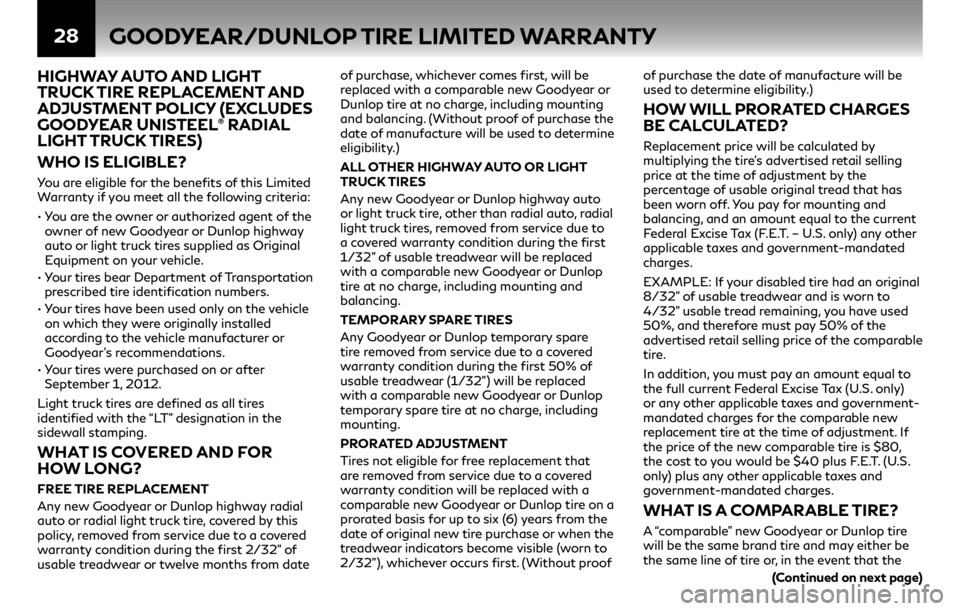
28GOODYEAR/DUNLOP TIRE LIMITED WARRANTY
HIGHWAY AUTO AND LIGHT
TRUCK TIRE REPLACEMENT AND
ADJUSTMENT POLICY (EXCLUDES
GOODYEAR UNISTEEL
® RADIAL
LIGHT TRUCK TIRES)
WHO IS ELIGIBLE?
You are eligible for the benefits of this Limited
Warranty if you meet all the following criteria:
• You are the owner or authorized agent of the
owner of new Goodyear or Dunlop highway
auto or light truck tires supplied as Original
Equipment on your vehicle.
• Your tires bear Department of Transportation prescribed tire identification numbers.
• Your tires have been used only on the vehicle on which they were originally installed
according to the vehicle manufacturer or
Goodyear’s recommendations.
• Your tires were purchased on or after September 1, 2012.
Light truck tires are defined as all tires
identified with the “LT” designation in the
sidewall stamping.
WHAT IS COVERED AND FOR
HOW LONG?
FREE TIRE REPLACEMENT
Any new Goodyear or Dunlop highway radial
auto or radial light truck tire, covered by this
policy, removed from service due to a covered
warranty condition during the first 2/32” of
usable treadwear or twelve months from date of purchase, whichever comes first, will be
replaced with a comparable new Goodyear or
Dunlop tire at no charge, including mounting
and balancing. (Without proof of purchase the
date of manufacture will be used to determine
eligibility.)
ALL OTHER HIGHWAY AUTO OR LIGHT
TRUCK TIRES
Any new Goodyear or Dunlop highway auto
or light truck tire, other than radial auto, radial
light truck tires, removed from service due to
a covered warranty condition during the first
1/32” of usable treadwear will be replaced
with a comparable new Goodyear or Dunlop
tire at no charge, including mounting and
balancing.
TEMPORARY SPARE TIRES
Any Goodyear or Dunlop temporary spare
tire removed from service due to a covered
warranty condition during the first 50% of
usable treadwear (1/32”) will be replaced
with a comparable new Goodyear or Dunlop
temporary spare tire at no charge, including
mounting.
PRORATED ADJUSTMENT
Tires not eligible for free replacement that
are removed from service due to a covered
warranty condition will be replaced with a
comparable new Goodyear or Dunlop tire on a
prorated basis for up to six (6) years from the
date of original new tire purchase or when the
treadwear indicators become visible (worn to
2/32”), whichever occurs first. (Without proof
of purchase the date of manufacture will be
used to determine eligibility.)
HOW WILL PRORATED CHARGES
BE CALCULATED?
Replacement price will be calculated by
multiplying the tire’s advertised retail selling
price at the time of adjustment by the
percentage of usable original tread that has
been worn off. You pay for mounting and
balancing, and an amount equal to the current
Federal Excise Tax (F.E.T. – U.S. only) any other
applicable taxes and government-mandated
charges.
EXAMPLE: If your disabled tire had an original
8/32” of usable treadwear and is worn to
4/32” usable tread remaining, you have used
50%, and therefore must pay 50% of the
advertised retail selling price of the comparable
tire.
In addition, you must pay an amount equal to
the full current Federal Excise Tax (U.S. only)
or any other applicable taxes and government-
mandated charges for the comparable new
replacement tire at the time of adjustment. If
the price of the new comparable tire is $80,
the cost to you would be $40 plus F.E.T. (U.S.
only) plus any other applicable taxes and
government-mandated charges.
WHAT IS A COMPARABLE TIRE?
A “comparable” new Goodyear or Dunlop tire
will be the same brand tire and may either be
the same line of tire or, in the event that the
(Continued on next page)
Page 33 of 60
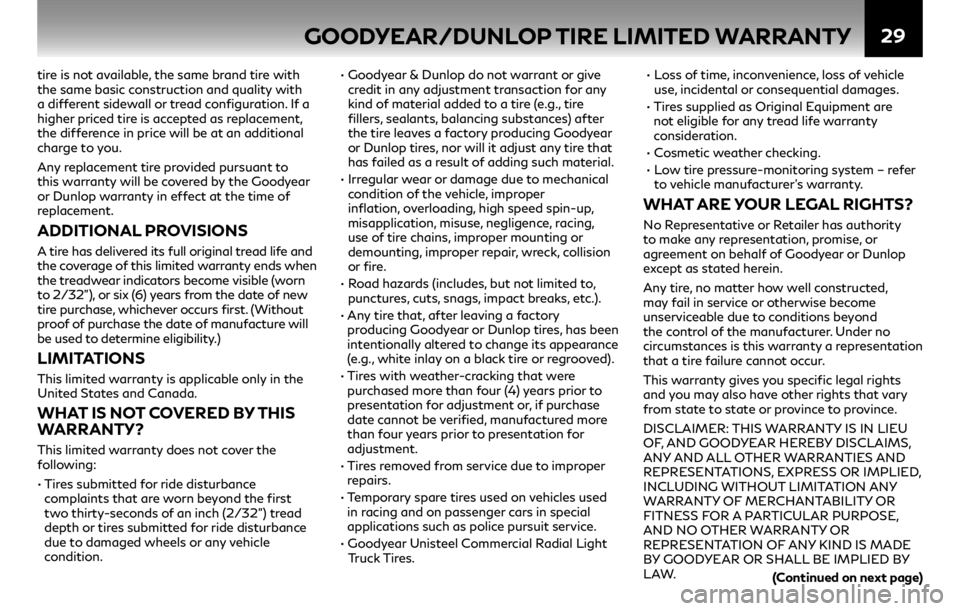
29
tire is not available, the same brand tire with
the same basic construction and quality with
a different sidewall or tread configuration. If a
higher priced tire is accepted as replacement,
the difference in price will be at an additional
charge to you.
Any replacement tire provided pursuant to
this warranty will be covered by the Goodyear
or Dunlop warranty in effect at the time of
replacement.
ADDITIONAL PROVISIONS
A tire has delivered its full original tread life and
the coverage of this limited warranty ends when
the treadwear indicators become visible (worn
to 2/32”), or six (6) years from the date of new
tire purchase, whichever occurs first. (Without
proof of purchase the date of manufacture will
be used to determine eligibility.)
LIMITATIONS
This limited warranty is applicable only in the
United States and Canada.
WHAT IS NOT COVERED BY THIS
WARRANTY?
This limited warranty does not cover the
following:
• Tires submitted for ride disturbance complaints that are worn beyond the first
two thirty-seconds of an inch (2/32”) tread
depth or tires submitted for ride disturbance
due to damaged wheels or any vehicle
condition. • Goodyear & Dunlop do not warrant or give
credit in any adjustment transaction for any
kind of material added to a tire (e.g., tire
fillers, sealants, balancing substances) after
the tire leaves a factory producing Goodyear
or Dunlop tires, nor will it adjust any tire that
has failed as a result of adding such material.
• Irregular wear or damage due to mechanical condition of the vehicle, improper
inflation, overloading, high speed spin-up,
misapplication, misuse, negligence, racing,
use of tire chains, improper mounting or
demounting, improper repair, wreck, collision
or fire.
• Road hazards (includes, but not limited to, punctures, cuts, snags, impact breaks, etc.).
• Any tire that, after leaving a factory producing Goodyear or Dunlop tires, has been
intentionally altered to change its appearance
(e.g., white inlay on a black tire or regrooved).
• Tires with weather-cracking that were purchased more than four (4) years prior to
presentation for adjustment or, if purchase
date cannot be verified, manufactured more
than four years prior to presentation for
adjustment.
• Tires removed from service due to improper repairs.
• Temporary spare tires used on vehicles used in racing and on passenger cars in special
applications such as police pursuit service.
• Goodyear Unisteel Commercial Radial Light Truck Tires. • Loss of time, inconvenience, loss of vehicle
use, incidental or consequential damages.
• Tires supplied as Original Equipment are
not eligible for any tread life warranty
consideration.
• Cosmetic weather checking.
• Low tire pressure-monitoring system – refer to vehicle manufacturer’s warranty.
WHAT ARE YOUR LEGAL RIGHTS?
No Representative or Retailer has authority
to make any representation, promise, or
agreement on behalf of Goodyear or Dunlop
except as stated herein.
Any tire, no matter how well constructed,
may fail in service or otherwise become
unserviceable due to conditions beyond
the control of the manufacturer. Under no
circumstances is this warranty a representation
that a tire failure cannot occur.
This warranty gives you specific legal rights
and you may also have other rights that vary
from state to state or province to province.
DISCLAIMER: THIS WARRANTY IS IN LIEU
OF, AND GOODYEAR HEREBY DISCLAIMS,
ANY AND ALL OTHER WARRANTIES AND
REPRESENTATIONS, EXPRESS OR IMPLIED,
INCLUDING WITHOUT LIMITATION ANY
WARRANTY OF MERCHANTABILITY OR
FITNESS FOR A PARTICULAR PURPOSE,
AND NO OTHER WARRANTY OR
REPRESENTATION OF ANY KIND IS MADE
BY GOODYEAR OR SHALL BE IMPLIED BY
LAW.
GOODYEAR/DUNLOP TIRE LIMITED WARRANTY
(Continued on next page)
Page 34 of 60
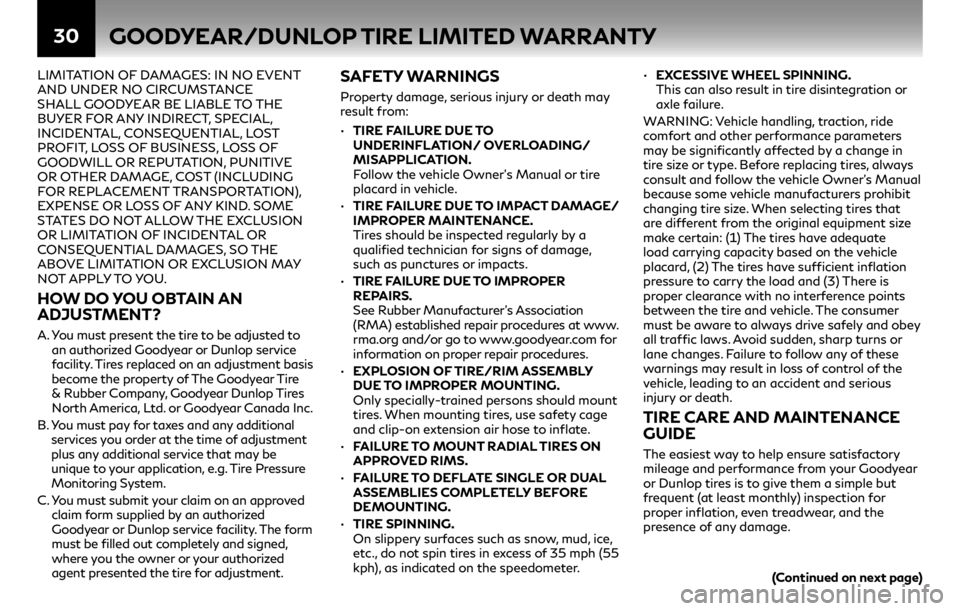
30
LIMITATION OF DAMAGES: IN NO EVENT
AND UNDER NO CIRCUMSTANCE
SHALL GOODYEAR BE LIABLE TO THE
BUYER FOR ANY INDIRECT, SPECIAL,
INCIDENTAL, CONSEQUENTIAL, LOST
PROFIT, LOSS OF BUSINESS, LOSS OF
GOODWILL OR REPUTATION, PUNITIVE
OR OTHER DAMAGE, COST (INCLUDING
FOR REPLACEMENT TRANSPORTATION),
EXPENSE OR LOSS OF ANY KIND. SOME
STATES DO NOT ALLOW THE EXCLUSION
OR LIMITATION OF INCIDENTAL OR
CONSEQUENTIAL DAMAGES, SO THE
ABOVE LIMITATION OR EXCLUSION MAY
NOT APPLY TO YOU.
HOW DO YOU OBTAIN AN
ADJUSTMENT?
A. You must present the tire to be adjusted to
an authorized Goodyear or Dunlop service
facility. Tires replaced on an adjustment basis
become the property of The Goodyear Tire
& Rubber Company, Goodyear Dunlop Tires
North America, Ltd. or Goodyear Canada Inc.
B. You must pay for taxes and any additional
services you order at the time of adjustment
plus any additional service that may be
unique to your application, e.g. Tire Pressure
Monitoring System.
C. You must submit your claim on an approved
claim form supplied by an authorized
Goodyear or Dunlop service facility. The form
must be filled out completely and signed,
where you the owner or your authorized
agent presented the tire for adjustment.
SAFETY WARNINGS
Property damage, serious injury or death may
result from:
•TIRE FAILURE DUE TO
UNDERINFLATION/ OVERLOADING/
MISAPPLICATION.
Follow the vehicle Owner’s Manual or tire
placard in vehicle.
• TIRE FAILURE DUE TO IMPACT DAMAGE/
IMPROPER MAINTENANCE.
Tires should be inspected regularly by a
qualified technician for signs of damage,
such as punctures or impacts.
• TIRE FAILURE DUE TO IMPROPER
REPAIRS.
See Rubber Manufacturer’s Association
(RMA) established repair procedures at www.
rma.org and/or go to www.goodyear.com for
information on proper repair procedures.
• EXPLOSION OF TIRE/RIM ASSEMBLY
DUE TO IMPROPER MOUNTING.
Only specially-trained persons should mount
tires. When mounting tires, use safety cage
and clip-on extension air hose to inflate.
• FAILURE TO MOUNT RADIAL TIRES ON
APPROVED RIMS.
• FAILURE TO DEFLATE SINGLE OR DUAL
ASSEMBLIES COMPLETELY BEFORE
DEMOUNTING.
• TIRE SPINNING.
On slippery surfaces such as snow, mud, ice,
etc., do not spin tires in excess of 35 mph (55
kph), as indicated on the speedometer. •
EXCESSIVE WHEEL SPINNING.
This can also result in tire disintegration or
axle failure.
WARNING: Vehicle handling, traction, ride
comfort and other performance parameters
may be significantly affected by a change in
tire size or type. Before replacing tires, always
consult and follow the vehicle Owner’s Manual
because some vehicle manufacturers prohibit
changing tire size. When selecting tires that
are different from the original equipment size
make certain: (1) The tires have adequate
load carrying capacity based on the vehicle
placard, (2) The tires have sufficient inflation
pressure to carry the load and (3) There is
proper clearance with no interference points
between the tire and vehicle. The consumer
must be aware to always drive safely and obey
all traffic laws. Avoid sudden, sharp turns or
lane changes. Failure to follow any of these
warnings may result in loss of control of the
vehicle, leading to an accident and serious
injury or death.
TIRE CARE AND MAINTENANCE
GUIDE
The easiest way to help ensure satisfactory
mileage and performance from your Goodyear
or Dunlop tires is to give them a simple but
frequent (at least monthly) inspection for
proper inflation, even treadwear, and the
presence of any damage.
GOODYEAR/DUNLOP TIRE LIMITED WARRANTY
(Continued on next page)
Page 35 of 60
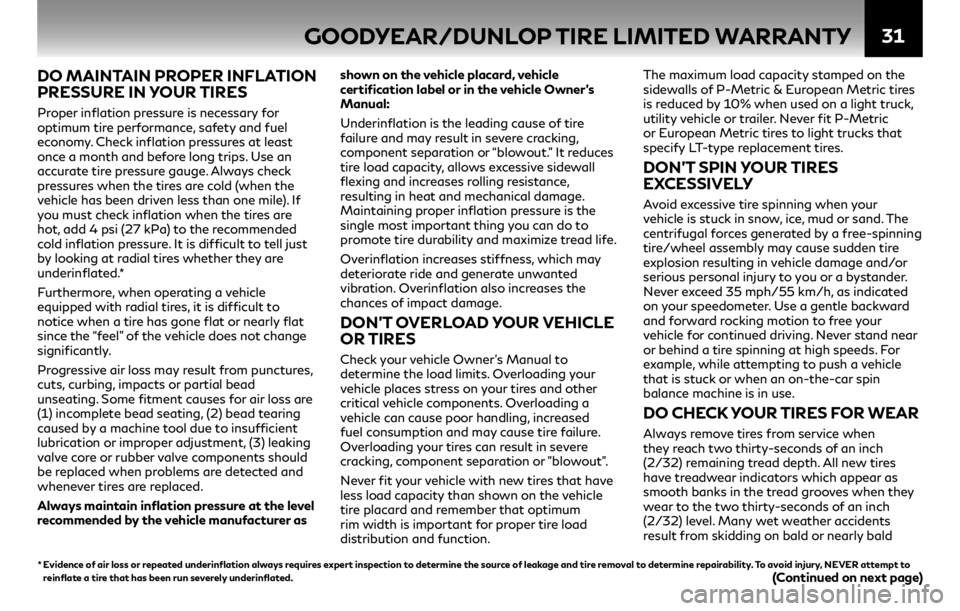
31
DO MAINTAIN PROPER INFLATION
PRESSURE IN YOUR TIRES
Proper inflation pressure is necessary for
optimum tire performance, safety and fuel
economy. Check inflation pressures at least
once a month and before long trips. Use an
accurate tire pressure gauge. Always check
pressures when the tires are cold (when the
vehicle has been driven less than one mile). If
you must check inflation when the tires are
hot, add 4 psi (27 kPa) to the recommended
cold inflation pressure. It is difficult to tell just
by looking at radial tires whether they are
underinflated.*
Furthermore, when operating a vehicle
equipped with radial tires, it is difficult to
notice when a tire has gone flat or nearly flat
since the “feel” of the vehicle does not change
significantly.
Progressive air loss may result from punctures,
cuts, curbing, impacts or partial bead
unseating. Some fitment causes for air loss are
(1) incomplete bead seating, (2) bead tearing
caused by a machine tool due to insufficient
lubrication or improper adjustment, (3) leaking
valve core or rubber valve components should
be replaced when problems are detected and
whenever tires are replaced.
Always maintain inflation pressure at the level
recommended by the vehicle manufacturer as shown on the vehicle placard, vehicle
certification label or in the vehicle Owner’s
Manual:
Underinflation is the leading cause of tire
failure and may result in severe cracking,
component separation or “blowout.” It reduces
tire load capacity, allows excessive sidewall
flexing and increases rolling resistance,
resulting in heat and mechanical damage.
Maintaining proper inflation pressure is the
single most important thing you can do to
promote tire durability and maximize tread life.
Overinflation increases stiffness, which may
deteriorate ride and generate unwanted
vibration. Overinflation also increases the
chances of impact damage.
DON’T OVERLOAD YOUR VEHICLE
OR TIRES
Check your vehicle Owner’s Manual to
determine the load limits. Overloading your
vehicle places stress on your tires and other
critical vehicle components. Overloading a
vehicle can cause poor handling, increased
fuel consumption and may cause tire failure.
Overloading your tires can result in severe
cracking, component separation or "blowout".
Never fit your vehicle with new tires that have
less load capacity than shown on the vehicle
tire placard and remember that optimum
rim width is important for proper tire load
distribution and function. The maximum load capacity stamped on the
sidewalls of P-Metric & European Metric tires
is reduced by 10% when used on a light truck,
utility vehicle or trailer. Never fit P-Metric
or European Metric tires to light trucks that
specify LT-type replacement tires.
DON’T SPIN YOUR TIRES
EXCESSIVELY
Avoid excessive tire spinning when your
vehicle is stuck in snow, ice, mud or sand. The
centrifugal forces generated by a free-spinning
tire/wheel assembly may cause sudden tire
explosion resulting in vehicle damage and/or
serious personal injury to you or a bystander.
Never exceed 35 mph/55 km/h, as indicated
on your speedometer. Use a gentle backward
and forward rocking motion to free your
vehicle for continued driving. Never stand near
or behind a tire spinning at high speeds. For
example, while attempting to push a vehicle
that is stuck or when an on-the-car spin
balance machine is in use.
DO CHECK YOUR TIRES FOR WEAR
Always remove tires from service when
they reach two thirty-seconds of an inch
(2/32) remaining tread depth. All new tires
have treadwear indicators which appear as
smooth banks in the tread grooves when they
wear to the two thirty-seconds of an inch
(2/32) level. Many wet weather accidents
result from skidding on bald or nearly bald
GOODYEAR/DUNLOP TIRE LIMITED WARRANTY
(Continued on next page)* Evidence of air loss or repeated underinflation always requires expert inspection to determine the source of leakage and tire removal to determine repairability. To avoid injury, NEVER attempt to
reinflate a tire that has been run severely underinflated.
Page 36 of 60

32
tires. Excessively worn tires are also more
susceptible to penetrations.
DO CHECK YOUR TIRES FOR
DAMAGE
Frequent (at least monthly) inspection of your
tires for signs of damage and their general
condition is important for safety. If you have
any questions, have your tire Retailer inspect
them. Impacts, penetrations, cracks, knots,
bulges or air loss always require tire removal
and expert inspection. Never perform a
temporary repair or use an inner tube as a
substitute for a proper repair. Only qualified
persons should repair tires.
PROPER TIRE REPAIR
NOTE: Goodyear and Dunlop do not warrant
any inspection or repair process. The repair is
entirely the responsibility of the repairer and
should be made in accordance with established
Rubber Manufacturers Association (RMA)
procedures.
TIRE PRESSURE MONITORING
SYSTEM ALERT
Refer to your vehicle Owner’s Manual for more
information on what to do if the tire pressure
warning system activates.
THE CONVENIENCE (TEMPORARY)
SPARE
The Convenience (Temporary) Spare is designed,
built, and tested to the high engineering
standards set by North America’s leading car
manufacturers and to Goodyear and Dunlop’s own high standards of quality control. It is
designed to take up a minimum of storage
space and, at the same time, fulfill the function
of a spare tire when needed. The spare is kept in
its storage space, fully inflated at 60 psi. To be
sure it is always ready for use, the air pressure
should be checked on a regular basis.
The Convenience (Temporary) Spare can be
used in combination with the original tires
on your vehicle. You can expect a tire tread
life of up to 3,000 miles (4,800 kilometers),
depending on road conditions and your driving
habits. To conserve tire tread life, return the
spare to the storage area as soon as it is
convenient to have the standard tire repaired
or replaced.
The Convenience (Temporary) Spare weighs
less than a standard tire so it’s easier to handle.
It also helps reduce the total car weight which
contributes to fuel economy.
The wheels used with the Convenience
(Temporary) Spare are specifically designed for
use with high pressure spares and should never
be used with any other type tire.
DON’T ATTEMPT TO MOUNT YOUR
OWN TIRES
Serious injury or Death may result from
explosion of tire/ rim assembly due to
improper mounting procedures. Follow tire
manufacturer’s instructions and match tire
diameter to rim diameter. Mount light truck
radials on rims approved for radial service. Do
not apply bead sealer. This can inhibit bead
seating. Lubricate beads and tire rim (including
tube or flap) contact surfaces. Lock assembly
on mounting machine or place in safety cage.
STAND BACK and never exceed 40 psi to
seat beads. Never use a volatile substance or a
rubber “donut” (also known as a bead expander
or “O-Ring”) to aid bead seating. Only
specially-trained persons should mount tires.
DON’T MIX TIRES OF DIFFERENT
SIZES AND TYPES ON THE SAME
AXLE
For optimum handling and control, Goodyear
and Dunlop recommend fitment of four (4) tires
of the same type and size unless otherwise
specified by the vehicle manufacturer.
WARNING: Before you replace your tires,
always consult the vehicle Owner’s Manual and
follow the vehicle manufacturer’s replacement
tire recommendations. Vehicle handling may
be significantly affected by a change in tire
size or type. When selecting tires that are
different than the Original Equipment size,
see a professional installer in order to make
certain that proper clearance, load carrying
capacity and inflation pressure is selected.
Never exceed the maximum load capacity and
inflation pressure listed on the sidewall of the
tire. Always drive safely and obey all traffic
laws. Avoid sudden, sharp turns or lane changes.
Failure to follow this warning may result in loss
of control of the vehicle, leading to an accident
and serious injury or death.
GOODYEAR/DUNLOP TIRE LIMITED WARRANTY
(Continued on next page)
Page 37 of 60

33
When replacing tires, you must maintain the
outside diameter and load carrying capacity of
the Original Equipment tire. Inflation pressure
may need to be adjusted to avoid overloading
the tire. Consult the Tire & Rim Association
Load and Inflation Tables, ETRTO or JATMA
standards for correct load and inflation
information.
NEVER FIT TIRES TO A VEHICLE
THAT HAVE LESS LOAD
CARRYING CAPACITY THAN AS
REQUIRED BY THE ORIGINAL
EQUIPMENT MANUFACTURER
Examples: Many vehicles, such as large
passenger vans, require Load Range E tires
as designated by the vehicle manufacturer.
Fitment of a tire, such as a Load Range D, with
less carrying capacity is not allowed.
In other cases, tires of the same size may carry
different load indexes in the service description.
You must make certain the replacement tires
fitted to the vehicle have a load carrying
capacity equal to or greater than what the
Original Equipment manufacturer specifies.
FOLLOW THESE ADDITIONAL
GUIDELINES
NOTE: Goodyear manufactured and/or
marketed European- Metric passenger
tires and P-Metric passenger tires are
interchangeable as long as they have the same
section width, same aspect ratio, same rim
diameter.
CAUTION
Never substitute a “Standard Load” (SL) tire
for an Extra Load (XL) tire. If the vehicle was
originally equipped with “Extra Load” (XL)
tires, replace those tires with similar sized
XL tires.
When installing only two tires, fit the tires with
the deepest tread depth on the rear axle. If
radials and non-radials must be fitted to the
same vehicle, fit radials on rear axle. Never
mix radials and non-radials on the same axle.
When fitting snow tires or all-season tires to
performance vehicles, always fit in sets of four.
It is not recommended to fit tires with different
speed ratings. If tires with different speed
ratings are installed on a vehicle, they should
be installed with like pairs on the same axle.
The speed capability of the vehicle will become
limited to that of the lowest speed rated tires.
Use of lift kits with some vehicle/tire
combinations can cause instability. When
changing tire sizes, always consult Retailer
for optimum rim width and carefully check
vehicle/tire clearances.
RETREADED TIRES
Retreaded passenger and light truck tires
are not warranted by Goodyear and Dunlop
for any reason. Goodyear and Dunlop speed
ratings and U.S. Department of Transportation
test compliance certifications are voided for
retreaded tires.
DO MAINTAIN VEHICLE
SUSPENSION, WHEEL ALIGNMENT
AND BALANCE AND ROTATE YOUR
TIRES
Lack of rotation, worn suspension parts,
underinflation/ overinflation, wheel imbalance
and misalignment can cause vibration
or irregular tire wear. Rotate your tires
according to your vehicle manufacturer’s
recommendations or at maximum intervals of
6,000 miles/10,000 km.
FOR ADDITIONAL INFORMATION, SEE
THE “BE TIRE SMART/ PLAY YOUR PART
BROCHURE” PUBLISHED BY THE RUBBER
MANUFACTURERS ASSOCIATION (RMA).
A COPY OF THIS BROCHURE CAN BE
DOWNLOADED FROM THE RMA WEBSITE:
www.rma.org/publications/consumer_tire_
information You must go to an authorized
Goodyear or Dunlop outlet for replacement
tires and all warranty service.
TIRE SERVICE LIFE
Tires are designed and built to provide many
thousands of miles of excellent service. For
maximum benefit, tires must be maintained
properly to avoid tire damage that may result
in removal from service before the tread is
worn down to minimum depth.
It is not practical to accurately predict the
service life of any specific tire in chronological
time since service conditions vary widely. The
serviceability of a tire over time is a function
GOODYEAR/DUNLOP TIRE LIMITED WARRANTY
(Continued on next page)
Page 38 of 60
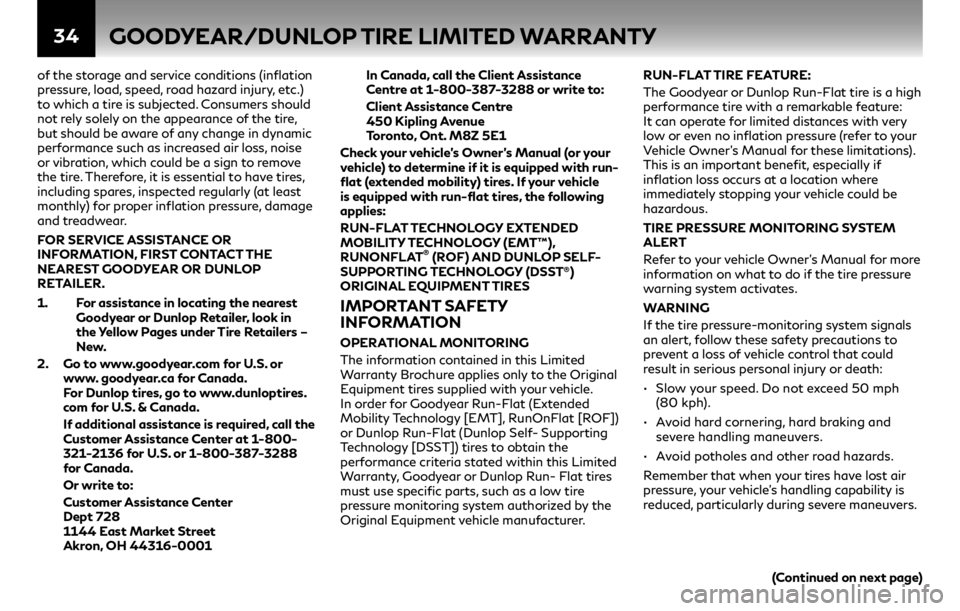
34
of the storage and service conditions (inflation
pressure, load, speed, road hazard injury, etc.)
to which a tire is subjected. Consumers should
not rely solely on the appearance of the tire,
but should be aware of any change in dynamic
performance such as increased air loss, noise
or vibration, which could be a sign to remove
the tire. Therefore, it is essential to have tires,
including spares, inspected regularly (at least
monthly) for proper inflation pressure, damage
and treadwear.
FOR SERVICE ASSISTANCE OR
INFORMATION, FIRST CONTACT THE
NEAREST GOODYEAR OR DUNLOP
RETAILER.
1. For assistance in locating the nearest Goodyear or Dunlop Retailer, look in
the Yellow Pages under Tire Retailers –
New.
2. Go to www.goodyear.com for U.S. or www. goodyear.ca for Canada.
For Dunlop tires, go to www.dunloptires.
com for U.S. & Canada.
If additional assistance is required, call the Customer Assistance Center at 1-800-
321-2136 for U.S. or 1-800-387-3288
for Canada.
Or write to:
Customer Assistance Center Dept 728
1144 East Market Street
Akron, OH 44316-0001 In Canada, call the Client Assistance
Centre at 1-800-387-3288 or write to:
Client Assistance Centre 450 Kipling Avenue
Toronto, Ont. M8Z 5E1
Check your vehicle’s Owner’s Manual (or your
vehicle) to determine if it is equipped with run-
flat (extended mobility) tires. If your vehicle
is equipped with run-flat tires, the following
applies:
RUN-FLAT TECHNOLOGY EXTENDED
MOBILITY TECHNOLOGY (EMT™),
RUNONFLAT
® (ROF) AND DUNLOP SELF-
SUPPORTING TECHNOLOGY (DSST®)
ORIGINAL EQUIPMENT TIRES
IMPORTANT SAFETY
INFORMATION
OPERATIONAL MONITORING
The information contained in this Limited
Warranty Brochure applies only to the Original
Equipment tires supplied with your vehicle.
In order for Goodyear Run-Flat (Extended
Mobility Technology [EMT], RunOnFlat [ROF])
or Dunlop Run-Flat (Dunlop Self- Supporting
Technology [DSST]) tires to obtain the
performance criteria stated within this Limited
Warranty, Goodyear or Dunlop Run- Flat tires
must use specific parts, such as a low tire
pressure monitoring system authorized by the
Original Equipment vehicle manufacturer. RUN-FLAT TIRE FEATURE:
The Goodyear or Dunlop Run-Flat tire is a high
performance tire with a remarkable feature:
It can operate for limited distances with very
low or even no inflation pressure (refer to your
Vehicle Owner’s Manual for these limitations).
This is an important benefit, especially if
inflation loss occurs at a location where
immediately stopping your vehicle could be
hazardous.
TIRE PRESSURE MONITORING SYSTEM
ALERT
Refer to your vehicle Owner’s Manual for more
information on what to do if the tire pressure
warning system activates.
WARNING
If the tire pressure-monitoring system signals
an alert, follow these safety precautions to
prevent a loss of vehicle control that could
result in serious personal injury or death:
• Slow your speed. Do not exceed 50 mph
(80 kph).
• Avoid hard cornering, hard braking and severe handling maneuvers.
• Avoid potholes and other road hazards.
Remember that when your tires have lost air
pressure, your vehicle’s handling capability is
reduced, particularly during severe maneuvers.
GOODYEAR/DUNLOP TIRE LIMITED WARRANTY
(Continued on next page)
Page 39 of 60
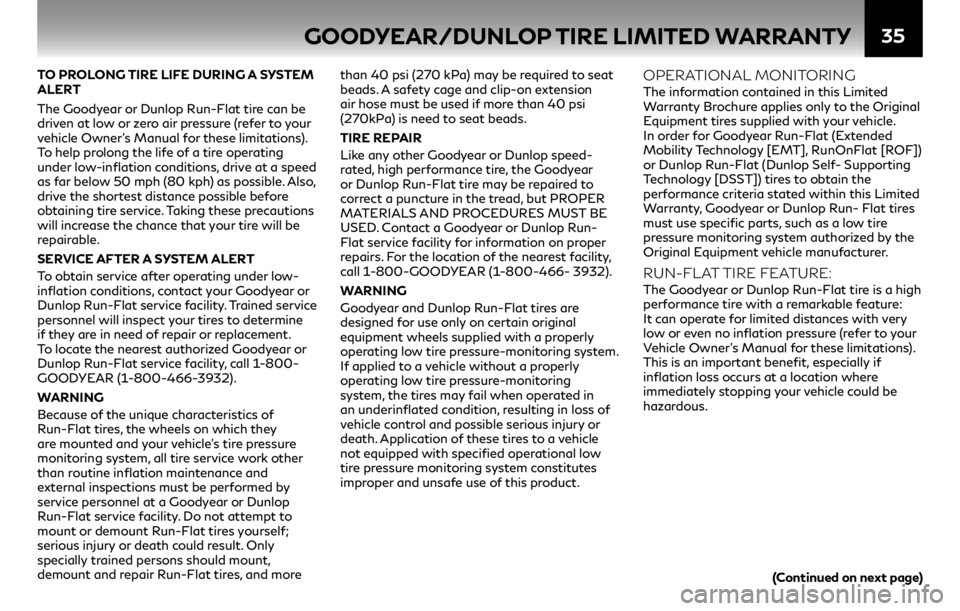
35
TO PROLONG TIRE LIFE DURING A SYSTEM
ALERT
The Goodyear or Dunlop Run-Flat tire can be
driven at low or zero air pressure (refer to your
vehicle Owner’s Manual for these limitations).
To help prolong the life of a tire operating
under low-inflation conditions, drive at a speed
as far below 50 mph (80 kph) as possible. Also,
drive the shortest distance possible before
obtaining tire service. Taking these precautions
will increase the chance that your tire will be
repairable.
SERVICE AFTER A SYSTEM ALERT
To obtain service after operating under low-
inflation conditions, contact your Goodyear or
Dunlop Run-Flat service facility. Trained service
personnel will inspect your tires to determine
if they are in need of repair or replacement.
To locate the nearest authorized Goodyear or
Dunlop Run-Flat service facility, call 1-800-
GOODYEAR (1-800-466-3932).
WARNING
Because of the unique characteristics of
Run-Flat tires, the wheels on which they
are mounted and your vehicle’s tire pressure
monitoring system, all tire service work other
than routine inflation maintenance and
external inspections must be performed by
service personnel at a Goodyear or Dunlop
Run-Flat service facility. Do not attempt to
mount or demount Run-Flat tires yourself;
serious injury or death could result. Only
specially trained persons should mount,
demount and repair Run-Flat tires, and more than 40 psi (270 kPa) may be required to seat
beads. A safety cage and clip-on extension
air hose must be used if more than 40 psi
(270kPa) is need to seat beads.
TIRE REPAIR
Like any other Goodyear or Dunlop speed-
rated, high performance tire, the Goodyear
or Dunlop Run-Flat tire may be repaired to
correct a puncture in the tread, but PROPER
MATERIALS AND PROCEDURES MUST BE
USED. Contact a Goodyear or Dunlop Run-
Flat service facility for information on proper
repairs. For the location of the nearest facility,
call 1-800-GOODYEAR (1-800-466- 3932).
WARNING
Goodyear and Dunlop Run-Flat tires are
designed for use only on certain original
equipment wheels supplied with a properly
operating low tire pressure-monitoring system.
If applied to a vehicle without a properly
operating low tire pressure-monitoring
system, the tires may fail when operated in
an underinflated condition, resulting in loss of
vehicle control and possible serious injury or
death. Application of these tires to a vehicle
not equipped with specified operational low
tire pressure monitoring system constitutes
improper and unsafe use of this product.OPERATIONAL MONITORINGThe information contained in this Limited
Warranty Brochure applies only to the Original
Equipment tires supplied with your vehicle.
In order for Goodyear Run-Flat (Extended
Mobility Technology [EMT], RunOnFlat [ROF])
or Dunlop Run-Flat (Dunlop Self- Supporting
Technology [DSST]) tires to obtain the
performance criteria stated within this Limited
Warranty, Goodyear or Dunlop Run- Flat tires
must use specific parts, such as a low tire
pressure monitoring system authorized by the
Original Equipment vehicle manufacturer.
RUN-FLAT TIRE FEATURE:The Goodyear or Dunlop Run-Flat tire is a high
performance tire with a remarkable feature:
It can operate for limited distances with very
low or even no inflation pressure (refer to your
Vehicle Owner’s Manual for these limitations).
This is an important benefit, especially if
inflation loss occurs at a location where
immediately stopping your vehicle could be
hazardous.
GOODYEAR/DUNLOP TIRE LIMITED WARRANTY
(Continued on next page)
Page 40 of 60

36
TIRE PRESSURE MONITORING
SYSTEM ALERT
Refer to your vehicle Owner’s Manual for more
information on what to do if the tire pressure
warning system activates.
WARNING
If the tire pressure-monitoring system signals
an alert, follow these safety precautions to
prevent a loss of vehicle control that could
result in serious personal injury or death:
• Slow your speed. Do not exceed 50 mph (80 kph).
• Avoid hard cornering, hard braking and severe handling maneuvers.
• Avoid potholes and other road hazards
Remember that when your tires have lost air
pressure, your vehicle’s handling capability is
reduced, particularly during severe maneuvers.
TO PROLONG TIRE LIFE DURING A
SYSTEM ALERT
The Goodyear or Dunlop Run-Flat tire can be
driven at low or zero air pressure (refer to your
vehicle Owner’s Manual for these limitations).
To help prolong the life of a tire operating
under low-inflation conditions, drive at a speed
as far below 50 mph (80 kph) as possible. Also,
drive the shortest distance possible before
obtaining tire service. Taking these precautions
will increase the chance that your tire will be
repairable.
SERVICE AFTER A SYSTEM ALERT
To obtain service after operating under low-
inflation conditions, contact your Goodyear or
Dunlop Run-Flat service facility. Trained service
personnel will inspect your tires to determine
if they are in need of repair or replacement.
To locate the nearest authorized Goodyear or
Dunlop Run-Flat service facility, call 1-800-
GOODYEAR (1-800-466-3932).
WARNING
Because of the unique characteristics of
Run-Flat tires, the wheels on which they
are mounted and your vehicle’s tire pressure
monitoring system, all tire service work other
than routine inflation maintenance and
external inspections must be performed by
service personnel at a Goodyear or Dunlop
Run-Flat service facility. Do not attempt to
mount or demount Run-Flat tires yourself;
serious injury or death could result. Only
specially trained persons should mount,
demount and repair Run-Flat tires, and more
than 40 psi (270 kPa) may be required to seat
beads. A safety cage and clip-on extension
air hose must be used if more than 40 psi
(270kPa) is needed to seat beads.
TIRE REPAIRLike any other Goodyear or Dunlop speed-
rated, high performance tire, the Goodyear
or Dunlop Run-Flat tire may be repaired to
correct a puncture in the tread, but PROPER
MATERIALS AND PROCEDURES MUST BE
USED. Contact a Goodyear or Dunlop Run-
Flat service facility for information on proper
repairs. For the location of the nearest facility,
call 1-800-GOODYEAR (1-800-466- 3932).
WARNING
Goodyear and Dunlop Run-Flat tires are
designed for use only on certain original
equipment wheels supplied with a properly
operating low tire pressure-monitoring system.
If applied to a vehicle without a properly
operating low tire pressure-monitoring
system, the tires may fail when operated in
an underinflated condition, resulting in loss of
vehicle control and possible serious injury or
death. Application of these tires to a vehicle
not equipped with specified operational low
tire pressure-monitoring system constitutes
improper and unsafe use of this product.
GOODYEAR/DUNLOP TIRE LIMITED WARRANTY